In the early months of 1980, Auckland’s inner city was invaded. It was an invasion that influenced the city musically for several years, filled the city’s live venues to capacity and gave the nation a No.1 record. The scene would dissipate rapidly when the invaders left their teen years behind. But 40 years on some of those people still play a major role in both Auckland and New Zealand’s music industry.
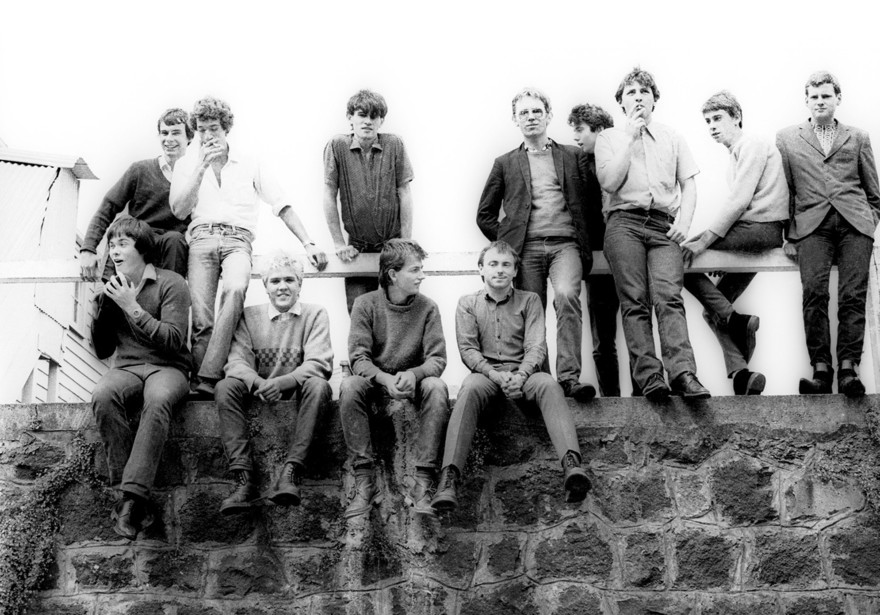
"North Shore Invasion": the Sunday News was the first to use the phrase, when publishing this photo of bands posing across the road from XS Café, on Airedale Street, 13 December 1980. - Anthony Phelps
Auckland’s North Shore had live venues and a thriving music scene going back to the early years of 20th century, but until the Auckland Harbour Bridge arrived in 1959, most of it was restricted to the population centres that existed around the connecting ferry routes: Devonport, Bayswater, Takapuna and the Northcote/Birkenhead townships in particular. Devonport also benefited from a large military presence. However, much of what we now think of as the North Shore was farmland, bush or wetlands.
Rapid access to the city via the Harbour Bridge changed that almost overnight and the paddocks quickly filled with houses and light industry, spreading through Milford and up to the desirable East Coast Bays and beyond. Large suburban sprawls appeared in Glenfield and Birkdale and into them came young couples, including many British immigrants who soon had families. The population of the North Shore doubled in 10 years.
The children of this post-bridge boom entered their teens in the 1970s and found themselves in a world where, apart from traditional pastimes such as sports, there was little to do. Into this mix, in the late 1970s, came punk rock which exploded the possibilities for both entertainment and creativity for young people.
“The North Shore suburbs were rife with teenagers and young adults discovering they could do it themselves, as demonstrated by the bands they identified with and listened to,” recalls Rowan Shedden of The Ainsworths and The Dabs. “Those bands range from punk (think Sex Pistols, The Clash), post-punk (Joy Division, PIL, New Order), power pop (Buzzcocks) and reggae/ska (The Specials, UB40, The Beat). All those bands were populated by young musicians who, when you looked at them and heard them, made you think, ‘I could do that too,’ so off you went and did it.”
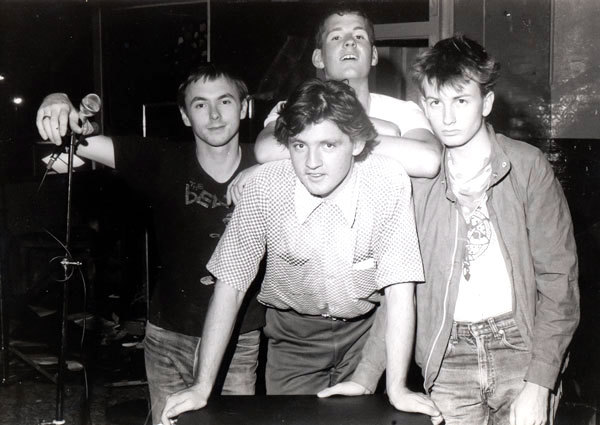
The Ainsworths: Rowan Shedden, Hilary Hunt, Phil Jackson, Adam Holt - Simon Grigg collection.
Adam Holt, formerly of The Ainsworths and now chairman of Universal Music New Zealand, has a similar memory: “Revolving around Rosmini College [Takapuna] and Takapuna Grammar, there were kids inspired by the first wave of Auckland punk rock in 1977 and 1978 who picked up instruments and formed bands. Most were amateur musicians at best, but every one of them was kicking again the mid-70s gloom and the schools’ rugby-obsessed environment.”
Andrew Boak (The Regulators and No Tag, now owner of Green Records, San Francisco) was not from either of those schools. But he found that at Westlake Boys, it was much the same. “I think it was a timing thing, with the urban development of the North Shore. Our ‘boomer’ parents all buying houses and having us kids around the same time, combined with the fact that we were exactly the right age when punk came along, late teens with attitude.”
Each Tuesday evening, television sets in houses with teens and young adults across the country almost universally tuned into the same hour of TV. Radio With Pictures was a music video show fronted until the end of 1979 by the infectiously opinionated Barry “Dr Rock” Jenkin. The programme increasingly identified with the edgy new wave of music coming out of the UK and the US, with its DIY attitude that (literally) told kids that anyone could form a band if you had the urge. Musical skills were a bonus, but not compulsory. Barry also hosted late night radio shows, first on Radio Hauraki and then on Radio New Zealand’s 1ZM, which were even less compromising in their programming, and were broadcast across the Auckland region. Bryan Staff, too, had a similar show on 1ZM and, by the end of 1979, New Zealand’s first punk and post-punk record label, Ripper.
These radio shows, like Radio With Pictures, were compulsory for anyone interested in the new music. Auckland city had witnessed an explosion of new punk and post-punk bands after 1977, and a multitude of live venues who hosted them, some non-liquor licensed and underage friendly – places like The Island of Real in Airedale Street (renamed XS Café in May 1980), and Squeeze in Fanshawe Street.
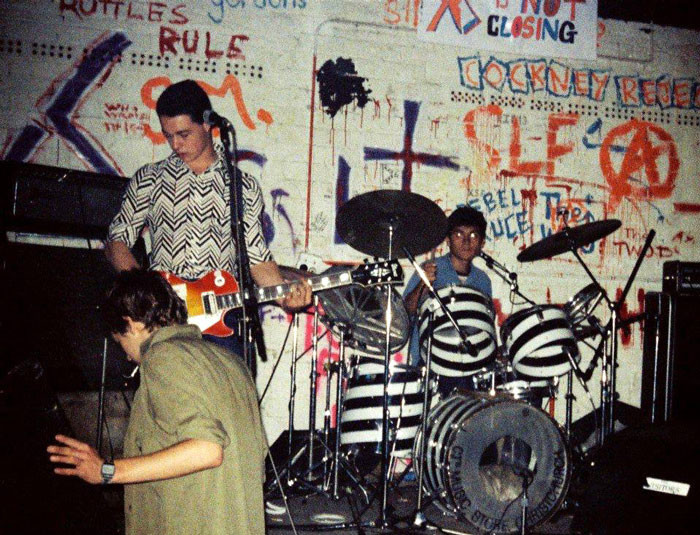
Andrew Boak and Richard Foulkes with The Regulators at XS Café. - Andrew Boak collection.
Andrew Boak: “Two of the main scene-stokers were Bryan Staff and Barry Jenkin. We would all stay up late and listen to them on 1ZM in glorious mono, or if one of them were doing midnight to dawn, we’d just tape it and listen the next day. Here was a ‘drink from the firehose’ situation, with music we just couldn’t buy anywhere but had read about in NME or Melody Maker, and it was right in our wheelhouse, being young, easily influenced music lovers. So many conversations at social parties etc started with, ‘Did you hear that song from [insert punk band name here]? Fuck it’s good, you should check it out. I heard Dr Rock play it last night. I think I have a recording of it, I’ll come around to your place tomorrow and we can listen to it and learn how to play it…’”
It was all very inspiring to a generation of restless and somewhat bored young men and women in their new suburbs, reading Rip It Up magazine and increasingly venturing across the harbour on weekends to see live music in the city. They formed bands, mostly at their schools, and began playing wherever they could, in music rooms, school halls and local church halls.
By the beginning of 1980, the nascent North Shore scene was ready to push over the bridge. The bands that arrived in the city’s venues were soon tagged as the North Shore Invasion by the media. It was at Rosmini, a Catholic boys’ school founded in 1962, that probably the most important band in the scene, and one that provided a catalyst for many of the others, was formed – The Screaming Meemees.
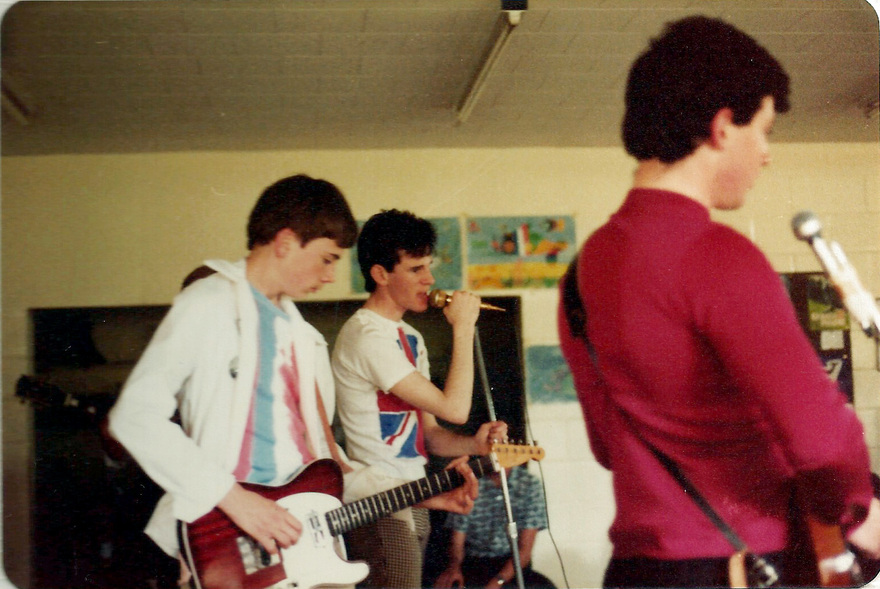
Peter van der Fluit, Tony Drumm and early guitarist (and first manager) Hilary Hunt, who would later form The Ainsworths. Taken in the art room at Rosmini College during the school fair, this is one of the first shots of The Screaming Meemees known to exist, probably 1979. - Adam Holt collection
Laurence Johan would become famous as their drummer under the mononym “Yoh” but back in 1979 he was still a schoolboy. “Pete [Van Der Fluit] and I were in a band at Rosmini,” he says, “playing 60s pop tunes like ‘Louie Louie’ mostly for fun during school holidays and after school, we never played any gigs. Hilary Hunt and Tony Drumm approached us one lunchtime saying they wanted to start a punk band. The next week Hilary told us he’d dated a girl whose brother had his own guitar and amp. That was Mike O’Neill. So Mike was approached and consequently joined the band.”
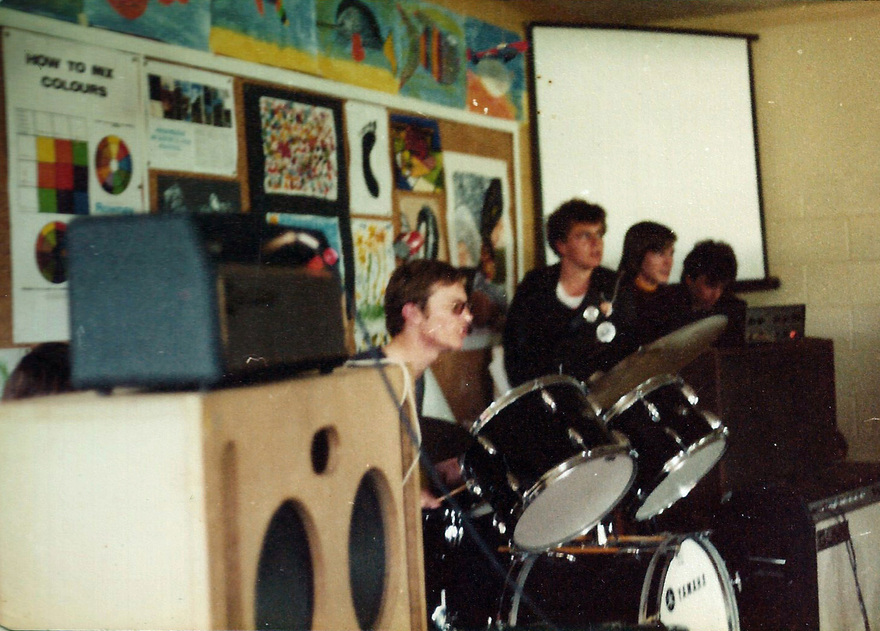
Yoh playing with The Screaming Meemees in the art room, Rosmini School Fair, probably 1979. - Adam Holt collection
The Screaming Meemees – who came second in a school talent quest with a cover of The Undertones’ ‘Teenage Kicks’ – seemed to have instinctively melded a fresh sound, meshing punk with 60s and 70s powerpop, mod and glam.
Adam Holt, part of the Rosmini music scene from day one, admits, “We were never scared of pop music ... it was a constant and shameless search for anything that would make a live audience dance.”
“[The Meemees] were influenced / inspired by the bands we saw in the city,” says Yoh, “Terrorways, Toy Love, Spelling Mistakes etc, but also we wanted to have our own sound. It was common for bands to do punk covers of 60s songs and we even covered ‘She’s a Mod’ [Ray Columbus and The Invaders]. Probably inspired by The Terrorways' version of that song, and also because Tony’s sister was at school with Ray’s daughter.”
The band and their fans, centred around their school friends and families, stepped ahead of the now very-clichéd punk look still seen in the city’s venues, adding a patchwork mod and 60s look that would soon influence the way Auckland’s crowds dressed.
“Growing up with four sisters,” guitarist Michael O’Neill told AudioCulture in 2014, “I’d become good [at sewing], so we’d hit the op shops and alter things ourselves ... I loved it, that whole thing of wanting something really badly but not being able to get it is fantastically creative, your mind fills in all the gaps … we loved it, all of it, and we started practising every week at school.”

The North Shore bands at XS Café, December 1980, promoted by Hils Hunt. - Michael O'Neill collection
The North Shore scene quickly coalesced into something more than just school gigs, driven in large part by the Meemees’ unofficial fifth member, Hilary Hunt. “The bands mostly just rehearsed on the weekends and didn’t know what to do next,” explains Rowan Shedden (The Ainsworths). “Fortunately, Hilary Hunt was around, knew us all, and got us gigs ... he was so over-the-top optimistic and gung-ho. The Meemees might never have got out of the garage without his organisational skills.”
Andrew Boak: “There was a growing group of teens getting together to organise gigs. We would borrow each other’s gear, and the vocal PA would consist of a cheap ten dollar microphone through the loudest guitar amp we had, so the whole punk DIY thing was very prevalent. Everyone knew about the gigs, so even if your band wasn’t playing, you would be at the gig supporting, plus it was the best entertainment around for us ... It was so word of mouth too, we didn’t have any communication tools other than our parents’ landline phones and other friends from the scene at our own school, so we did pretty much a great job.”
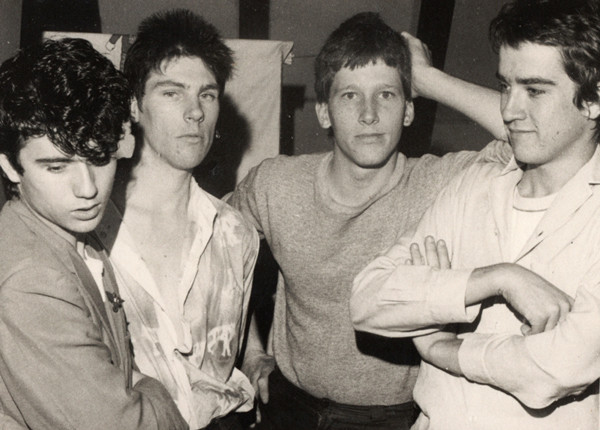
Rebel Truce: Dean Martelli, Adolf Soeteman, Phil and Dave O'Donahue - Simon Grigg collection
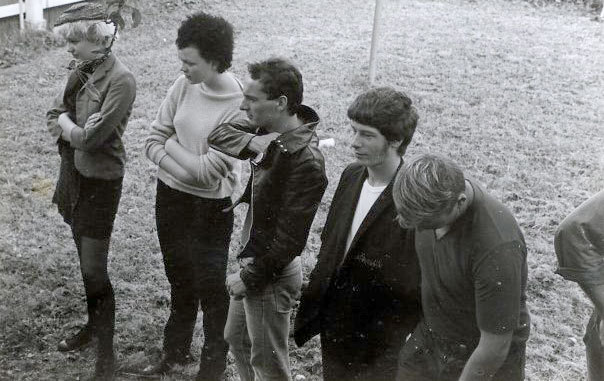
Alms For Children and friends, 1981.
Hilary Hunt soon had his own band too, The Ainsworths, with fellow Rosmini schoolboys, Adam Holt, Rowan Shedden, and Phil Jackson. The Meemees and Ainsworths shared a stage in the numerous halls around Takapuna, Northcote and Glenfield. Two bands became three and then four and more, and combinations of The Killjoys, The Regulators, Rebel Truce, The Moderns, Little Inches, The Flicks, Alms For Children and others were often found on the same bills, playing together and sporadically being mentioned in the important weekly music pages of the Auckland Star and New Zealand Herald. Influential writers Louise Chunn and Colin Hogg were attentive towards, and supportive of, the wider Auckland band scene and regularly spotted and namechecked new acts. Colin Hogg’s Auckland Star columns in particular were widely read and helped to break both bands and records in the Queen City.
Across the bridge
Legend has it that the earliest appearances by the new wave of North Shore bands on the mainland were in Squeeze, the popular downstairs underage club on Fanshawe Street. However, Hilary Hunt had earlier managed to push The Screaming Meemees onto supports in February and March at the licensed upstairs bar Liberty Stage on Symonds Street, first for The Primmers, then Sheerlux and The Respectables, before they played the underage venues. Adam Holt confirms that “the Meemees made the first forays into pubs over the bridge … and then clubs like XS Café and Squeeze made it easy to play in proper venues. We followed the Meemees to the city and I suppose then ‘the invasion’ began.”
For Yoh, the gigs had an unfortunate side effect. “That’s probably why I was asked to leave Rosmini ... after absorbing Karel Van Bergen and co [The Primmers] for intensity and fun on Thursday night I had two hours of maths followed by two hours of applied maths on a Friday morning! You couldn’t blame me for sleeping through some of it.” As a result, he was now the first fulltime musician in the new North Shore band scene.
Hilary Hunt booked the Meemees into Squeeze for the first time in March 1980, to raise money for the Rosmini School Ball, which allowed the band’s underage teen fans to fill the venue. Rowan Hunt was there: “It was an unknown territory. I didn’t know how to break into it or who was who. It took that one gig at Squeeze to fix all that, however, and there was no looking back after then. From the one gig flowed many more.”

The Screaming Meemees at XS Cafe, late 1980 - Photo by Anthony Phelps.
I first remember The Screaming Meemees as a judge at the Rockquest’80 at Parnell’s Windsor Castle on Easter Monday where, despite the fact they were a late and unadvertised entry, they impressed enough for the judges to give them a special mention. However, they were up against crowd favourites The Spelling Mistakes, who were almost pre-determined winners. It was the first mention of any of this generation of North Shore bands in Rip It Up, a magazine that was to become very important to the bands from over the harbour.
From Squeeze, the Meemees and the other Shore bands soon found gigs at XS Café, an altogether more daunting experience. “It was just dangerous, we were physically scared every time we played, but it was also so outrageous and so much fun. The place was crawling with kids, on the stage, all over the speakers, it was madness and we’d be shitting ourselves and hugely excited at the same time,” Meemees bassist Peter van der Fluit told writer Alan Perrott, for AudioCulture, in 2014.

XS Café gig guide advert, Dec 80 - Jan 81 - Rip It Up Archives
XS Café had largely replaced Zwines as the boot-boy club after the latter had been firebombed the previous year. The venue was notorious for the often extended – both in time and space – brawls, which sometimes involved the police. Toughened up by their nights there, the Meemees were soon playing at more pubs, supporting The Features, a band who were popular with the boot-boy crowd, at Liberty Stage mid-year and headlining with John (the band) at The Reverb Room. By August, The Killjoys, Regulators, Rebel Truce and The Ainsworths were filling North Shore themed nights at XS, bolstered by the inevitable carloads of young followers who came from the Shore.
Boak: “The other important people in the scene were those with cars, otherwise we’d never get gear, or ourselves to gigs to play, or get into the city to support the North Shore bands. So those folks were very very important … we were learning when we were able to see bands at the underage venues – we were really underage, and that was the first place most of us got to play in the ‘big’ city.
“Then, after a while, we would get to know enough people in the actual scene to be able to play Reverb and Rumba, and occasionally Mainstreet, first as support bands, and later on, as headliners.”
Yoh also remembers the tight camaraderie amongst the Shore kids, especially those centred around the O’Neill family. “We were like an extended family, a mob that partied together. We looked after each other, kept each other in line.”
Adam Holt adds, “XS Café and Squeeze were the most important – they were the start of everything for our bands – we could play there legally, and they were always super supportive of us. The North Shore bands always drew lots of girls and that always made for good crowds, which must have been appealing to the venues.”
--